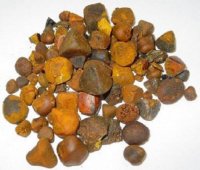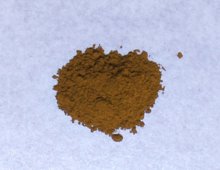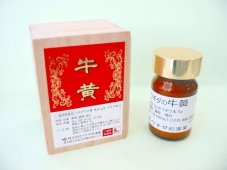Japanese Folk Medicine
- Vol. 1 - Bezoar Bovis (Oriental Bezoar) -牛黄-

-
 Bezoar Bovis
Bezoar Bovis -
 Bezoar Bovis Powder
Bezoar Bovis Powder -
 Bezoar Bovis Product
Bezoar Bovis Product
Origin
Bezoar Bovis (Goo in Japanese) is a medicine derived from the gallstones formed in the gallbladder or biliary ducts of the cow Bos taurus L. var. domesticus Gmelin, which belongs to the Bovidae family.
It is mainly produced in countries that have extensive meat processing facilities because cow gallstones are only found in 1 in 1000 cows. Thus, the main producer countries are China, Australia, Brazil, Argentina, and India, and the medicine produced in Australia is said to be of high quality. Due to the difficulties in its production, Bezoar Bovis is regarded as the second most expensive traditional Chinese medicine next to Moschus (Jakou: 麝香in Japanese), and fake versions of it are sold in some regions. At present, all Bezoar Bovis products sold in Japan are imported.
The most common form of Bezoar Bovis is globular, but triangular pyramidal and cubic forms are sometimes found. The diameter of the globular form ranges from 1 to 4 centimeters; its outer surface is brownish yellow or reddish brown in color; and because Bezoar Bovis is a light and fragile substance, it is easy to crush. A circular layered pattern is observed in its cross sections. Bezoar Bovis that induces strong nausea after a small amount has been crushed in the mouth and spread on the tongue by saliva is said to be of higher quality. In addition, a low weight and a bitter/subtly sweet taste are also considered to be indicative of a higher quality product.
Recently, artificial and cultured Bezoar Bovis have become widely available in China and other countries as cheaper alternative sources of the crude drug. Artificial Bezoar Bovis is produced by removing bile from cows without killing them before synthesizing the gallstones extracorporeally, and cultured Bezoar Bovis is obtained by injecting calculus-causing bacteria into the gallbladders of cows by surgical means, which is very effective at producing gallstones.
The medicine can be collected throughout the year. It is packed in light-resistant sealed containers and should be stored in a cold dark place in order to prevent moisture getting into the product and the pressure inside the packaging reducing.
History
Bezoar Bovis was categorized as a shang-pin (上品) in the oldest medicinal literature in China, the Shennong-bencaojing (神農本草経), which described it as a 'perpetual youth and longevity medicine' and a 'life support medicine' because its consumption promotes metabolic function; i.e., it increases the patient's energy levels and has anti-aging and life-extending effects. In ancient China, as Bezoar Bovis was more expensive than gold, it was presented to emperors.
The Taiho-ritsuryo (大宝律令), the oldest known administrative code enacted in Japan, stated that 'If a man discovered Bezoar Bovis when he killed cows, he should present it to the central government'; therefore, we think that Bezoar Bovis was well known to many people from about the seventh century. However, Bezoar Bovis is said to have originated in the fifth century in India. We assume that Bezoar Bovis was initially used as a medicine in India or China and was then carried with Buddhism through the Korean Peninsula and into Japan in the Asuka era because it was mentioned in the main scriptures of Mahayana Buddhism, the Konkomyokyo (金光明経) , which established in northern India. Furthermore, it was also transported through Persia and into England and France, where it was used as an antidote. In addition, Ieyasu Tokugawa, a shogun with an interest in medicine, used Bezoar Bovis habitually because it was highly prized by the upper class, e.g., shoguns, their staff, and feudal lords in the Edo era.
Compounds
Bezoar Bovis contains the following compounds: cholic acid; deoxycholic acid; cholesterol; bilirubin; ergosterol; vitamin D; calcium; magnesium; zinc; iron; copper; phosphorus; and amino acids, e.g., taurine, arginine, and methionine.
Pharmacological effects and toxicity
Bezoar Bovis is described in Japanese pharmacopoeia. The fifteenth Japanese pharmacopoeia of practical guide states that Bezoar Bovis has blood pressure-lowering, anti-pyretic, anti-hypoxic brain disorder, analgesic, sedative, cardiotonic, cholagogic, anti-spasmodic, anti-inflammatory, and anti-intravascular coagulation effects. Thus, its powdered form is used as a medicine (to be taken as needed) for suppressing discomfort caused by palpitations, cooling individuals with sunstroke (via its bitter taste), and alleviating throat soreness. In addition, the above literature states that Bezoar Bovis is mainly used as a crude material for producing combination drugs.
Water extract of Bezoar Bovis increased the amplitude of heart movements in isolated rabbit and toad hearts and inhibited the irregular contractions induced in cultured mouse heart cells by a high calcium concentration. The blood pressure of rabbits is increased by the intravenous infusion of Bezoar Bovis water extract, while that of the spontaneously hypertensive rats is decreased. In addition, bile secretion is enhanced by a similar treatment.
There have not been any reports of serious side effects, but caution should be exercised in pregnant women, and Bezoar Bovis is contraindicated for weak people who often suffer from diarrhea associated with chills.
Medicinal effects, dosage, and administration
Bezoar Bovis tastes bittersweet, is non-toxic, and also produces a cool sensation. It is considered to have mind-cleansing, expectorant, cholagogic, and shock-quelling effects. The 'Shennong-bencaojing' described '主驚癇寒熱熱盛狂痓 除邪逐鬼' as a shang-pin (上品) ; thus, it is mainly used for the treatment or prevention of consciousness disturbance or spasms caused by febrile, crying at night in children, stroke, mental instability, inflammation, or pyosis.
Bezoar Bovis was mentioned in the medical literature produced after the Liu Chao dynasty in China and was categorized as fangxiang-kaiqiaoyao (芳香開竅薬), an aromatic medicine that causes the release of qi; hence, it has a good smell, removes negative vibes, and aids the recovery of consciousness. Bezoar Bovis is said to affect consciousness disturbances caused by high fever, inflammation, or spasm. In particular, the effects of Bezoar Bovis on spasms caused by cerebral vascular disturbances, e.g., stroke and cerebral infarction, are thought to be mediated by increases in the number of distal red blood cells and antioxidant effects. Recently, the application of Bezoar Bovis to senile dementia was also studied due to its ability to improve the flow of blood. Furthermore, Bezoar Bovis is used for chronic hepatitis and cirrhosis because it can cool fevers and has antidotal and cholagogic effects.
In Japan, Bezoar Bovis has been the most expensive traditional medicine since the Asuka era and is used for anemia, cold sensitivity, individuals with weak constitutions, and refreshment (both during and after illness) because it increases red blood cell production, and has a tonic effect. In addition, Bezoar Bovis is administered for stroke, cerebral infarction, cerebral vascular disease, arteriosclerosis, angina, high blood pressure, and dementia because it can dissolve thrombi and lower blood pressure, and it is given to patients with heart disease, angina, palpitations, irregular heartbeats, breathlessness, edema, or hypotension because of its cardiotonic effects. It is also recommended for insomnia, neurosis, nervosity, catatonia, depression, stress-related illnesses, and headache because of its sedative and consciousness-restoring effects and is used for limb numbness, stomachache, stiff shoulders, coughing, and asthma because of its anti-spastic effects. Furthermore, it is considered to be effective against fevers caused by cold or infection, unexplained fevers, and cold symptoms because of its anti-inflammatory and antipyretic effects, and it is also administered for chronic hepatitis, cirrhosis, and liver cancer because of its choleretic and hepatoprotective effects. Thus, Bezoar Bovis is used to treat a variety of conditions.
Powdered Bezoar Bovis is taken orally so that it melts on the tongue. It is used at daily doses of 2 to 200 mg to treat palpitations, breathlessness, dizziness, and discomfort caused by palpitations; to cool individuals with sunstroke (via its bitter taste); and to alleviate throat soreness, while it is taken at daily doses of 100 to 200 mg to treat heat stroke, altitude sickness, excitatory states, and abnormal behavior in babies; to cool fevers; and for detoxification. Bezoar Bovis is a relatively rapidly acting agent. In urgent cases, 100 to 200 mg of the powdered form of the medicine are taken orally.
Bezoar Bovis is used on its own as an antipyretic or antispasmodic, or as a cardiotonic for heart problems caused by heat disorder, and it is also used as the main component of drugs for treating palpitations or breathlessness, tonics, or as a crude material for household medicine. Moreover, Bezoar Bovis is used in various formulas; e.g., Kyushin (救心) , Rokushingan (六神丸) , Kannogan (感応丸) , Seishingan (清心丸) (composed of Bezoar Bovis, Ginseng, and Angelica root, etc.), and Reiousan (霊黄参) (a tonic composed of Bezoar Bovis and Ginseng), and it can also be taken as an emergency lifesaving drug. Formulas containing greater amounts of Bezoar Bovis are slightly soluble in water but very soluble in saliva; thus, it is better to apply them under the tongue and allow them to melt gradually. Although 2 mg quantities are blended with Rokushingan (六神丸) or Uzukyumeigan (宇津救命丸) for one-day treatments, such quantities are considered to be very small.
Others
The medicinal literature Shennong-bencaojing-jizhu (神農本草経集注), which was written by Hongjing Tao in the Liang dynasty (the 5th to 6th century), mentioned '療小児百病諸癇熱口不開大人狂癲 久服軽身増年令人不忘' in a quote from Mingyi-bielu (名医別録), which was written in the Han dynasty. The passage suggested that Bezoar Bovis can be used to treat all diseases in children, the person who has a high fever, grit their tooth and stop opening a mouth, and confusion in adults. In addition, if it is taken over a long period of time, it is metabolized briskly, extend one's life, and aids memory.
Bezoar Bovis is not used as a decoction because it is not soluble in water. The powdered form of the medicine can be taken from a glass container for emergent use. If the powder is wrapped in medical paper directly, the ingredients will be absorbed into the paper. In pediatric cases, if an abundant amount is taken, a transient body temperature decrease is induced.
Reference
F. Ikegami, Wakanyaku, 699, 15-17, (2011.8)
